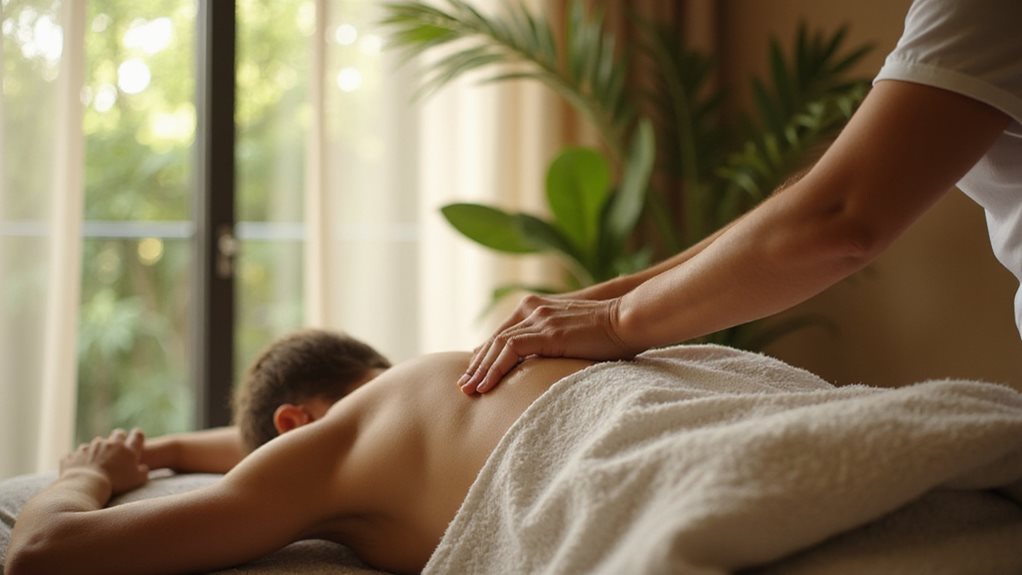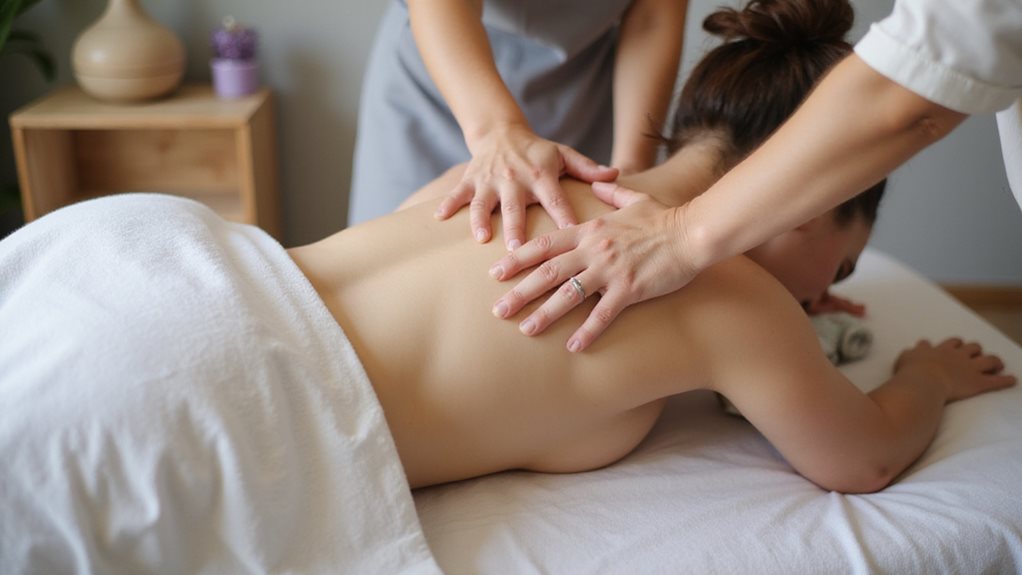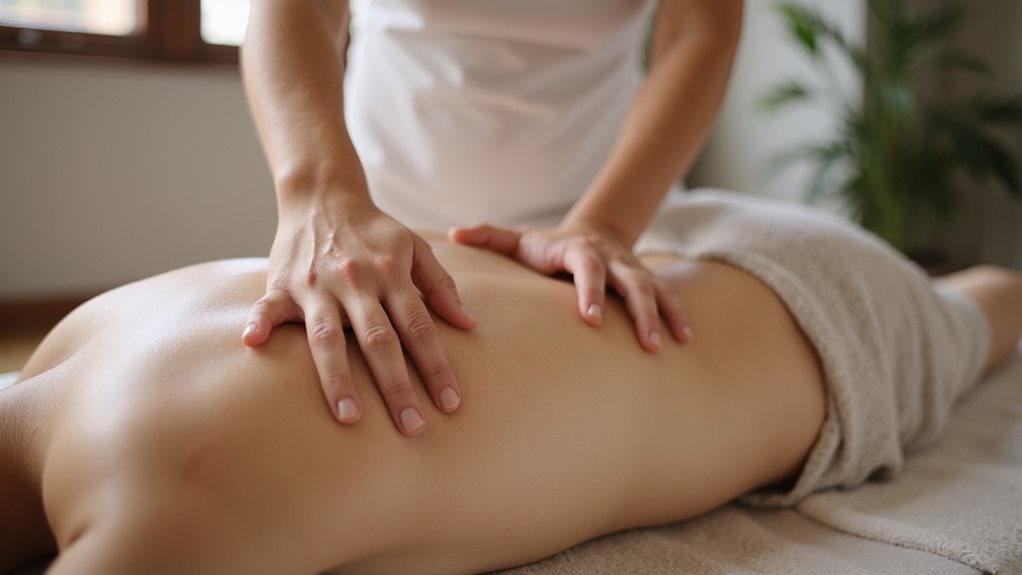Reflexology and pain management are helping more people feel better every day. This type of massage applies pressure to specific points on the hands and feet to alleviate pain in other parts of the body. It’s a natural way to help your body relax and heal.
Many people find that reflexology and pain management work well together. This gentle therapy doesn’t just help with sore muscles—it can also reduce stress and enhance your body’s movement. Even kids and older adults can benefit from it.
If you’ve been dealing with pain or stress, reflexology might be an excellent option. It is safe, calming, and doesn’t use medicine. Please keep reading to learn how it works and who it helps most.
Key Takeaways
- Therapeutic massage significantly reduces pain in chronic conditions like fibromyalgia and osteoarthritis.
- It interrupts pain signals using gate control theory, offering natural relief.
- Techniques like deep tissue target muscle tension for effective pain management.
- Massage lowers cortisol and boosts serotonin, helping to break the cycle of pain and stress.
Impro
Understanding Therapeutic Massage
Therapeutic massage is a cornerstone of holistic wellness. It focuses on manipulating soft tissues such as muscles, tendons, and ligaments to promote healing and relaxation. It offers a nurturing path for those seeking connection and care, addressing personal needs through tailored approaches.
Techniques such as effleurage, kneading, and lymphatic drainage enhance circulation, alleviate tension, and support holistic health goals, inviting everyone to a shared path of well-being.
As a versatile practice, massage therapy for pain management adapts to diverse conditions with adaptable pressure and targeted methods. Whether through Swedish massage for relaxation or deep tissue therapy for more severe concerns, it promotes systemic benefits, such as improved lymphatic function. This inclusive practice invites all to experience its restorative welcome with empathy and expertise.
Additionally, therapeutic massage can significantly reduce stress levels by lowering cortisol levels and increasing serotonin and dopamine levels, thereby enhancing emotional well-being.
Benefits of Massage for Pain Management
Therapeutic massage offers significant benefits for pain management, with evidence demonstrating its capacity to reduce pain levels in people with chronic conditions. Studies show a notable decrease in discomfort, as measured by standardized methods, providing a natural alternative to pharmaceutical interventions. Furthermore, it promotes improved muscle relaxation, easing tension and supporting physical recovery for those in distress.
Research also indicates that massage therapy can improve quality of life for patients with conditions like fibromyalgia and among breast cancer survivors.
Proven Pain Reduction
For countless people grappling with persistent discomfort, massage therapy offers a compelling, non-invasive solution for pain management. By interrupting pain signals through gate control theory and reducing inflammatory cytokines, it mirrors the effects of medications without side effects. This therapy also improves blood flow, clearing metabolic waste and aiding tissue recovery.
Moreover, it effectively targets chronic conditions like fibromyalgia by improving joint mobility and easing postsurgical pain through gentle tissue restoration. It breaks the stress-pain cycle by lowering cortisol levels and increasing mood-enhancing chemicals, such as serotonin. Additionally, therapeutic massage promotes healing by enhancing lymphatic drainage, which supports the body’s natural detoxification processes.
For those seeking a supportive community in their healing process, massage provides not only physical relief but also a sense of connection, fostering well-being through proven, holistic pain reduction strategies.
Enhanced Muscle Relaxation
Many people struggling with persistent muscle tension find significant relief through massage therapy, a proven method for improving muscle relaxation. This approach uses targeted pressure to release knots and alleviate stiffness, while gentle techniques promote deep relaxation, easing both physical pain and mental stress. Improved circulation aids muscle healing, reducing fatigue and maintaining flexibility for better movement.
Additionally, massage therapy is widely recognized as a complementary approach to traditional treatments for pain management within the field of integrative medicine. Here’s how massage fosters a sense of ease and connection:
- Releases everyday aches from physical stress.
- Soothes tight muscles for better sleep quality.
- Supports recovery alongside physical therapy.
- Improves mood by reducing muscle strain.
- Builds a holistic sense of wellness.
Through these benefits, people often feel renewed, finding a supportive path to manage tension and attain a more relaxed state of being.
How Massage Compares to Other Therapies
How does massage therapy compare to other treatment options for pain and dysfunction? For many seeking relief, massage offers a promising alternative. Studies show that it outperforms usual care, with relaxation massage improving function by 2.9 points on the Roland Disability Questionnaire at 10 weeks and structural massage by 2.4 points.
Both reduce symptom bothersomeness more than standard care, sometimes lasting up to a year.
Compared to a placebo, massage therapy demonstrates greater pain reduction in specific scenarios, such as chronic low back pain with myofascial release. While evidence varies across techniques and conditions, consistent sessions—often 60 minutes multiple times weekly—yield better outcomes. Despite hundreds of trials, the evidence base for massage therapy remains limited in achieving high-certainty conclusions.
For those yearning for effective, non-pharmacologic solutions, massage stands as a valuable, community-supported path to wellness.
Key Conditions Treated by Massage

Therapeutic massage can benefit a wide range of health conditions, making it a versatile option for those seeking relief. This holistic approach addresses both physical and psychological challenges, fostering a sense of well-being and connection. Many people find comfort in massage as it supports recovery and eases discomfort from diverse ailments.
Additionally, massage therapy enhances blood circulation, delivering vital nutrients and oxygen to tissues while removing waste products, and improves blood flow.
Therapeutic massage offers versatile relief for many health conditions, blending physical and psychological healing to foster well-being and comfort.
Here are key conditions often treated with massage:
- Anxiety: Helps calm the mind and reduce overwhelming feelings.
- Stress-related tension: Eases tightness, promoting relaxation.
- Insomnia: Encourages better sleep through stress reduction.
- Fibromyalgia: Alleviates widespread pain and tenderness.
- Sports injuries: Aids in recovery and restores mobility.
Through therapeutic touch, massage offers a nurturing path to healing, inviting everyone to experience its comforting benefits within a supportive community.
Chronic Pain and Massage Therapy

Chronic pain affects millions, and massage therapy offers a promising approach to managing this persistent condition with evidence supporting its efficacy. It also provides significant muscle relaxation benefits, easing tension and stiffness that often exacerbate discomfort in affected people. By addressing these physical barriers, massage therapy can enhance daily function, helping individuals regain mobility and improve their overall quality of life.
Regular sessions over months or years can help sustain relief, especially when combined with lifestyle changes such as maintaining improved posture and engaging in regular exercise.
Managing Chronic Pain
Why do so many people grappling with persistent discomfort turn to therapeutic massage for relief? For those living with chronic pain, this hands-on approach offers a source of hope. Research shows it effectively alleviates pain in conditions like fibromyalgia, osteoarthritis, migraines, and even cancer-related discomfort.
Tuina, a form of Chinese massage, has been shown to reduce chronic nonspecific low back pain significantly. Compared to no treatment or other interventions, massage demonstrates superior pain reduction, providing a meaningful decrease in pain intensity for adults. Here’s why it resonates with so many. It’s a natural, non-invasive option.
- Offers tailored care for specific pain patterns.
- Proven relief for diverse chronic conditions.
- Fosters a sense of comfort and support.
- Connects people to a healing community.
- Studies confirm that massage effectively relieves chronic pain in various body areas, including the back, neck, and knees.
Muscle Relaxation Benefits
People with chronic pain often find therapeutic massage a powerful tool for relief, particularly through its profound impact on muscle relaxation. By increasing blood flow, massage delivers oxygen and nutrients to strained tissues, aiding recovery while reducing stiffness through thermal effects. It also decreases neurological excitability, curbs muscle spasms, and releases restrictive fascia, enhancing mobility.
Moreover, massage interrupts the pain-stress cycle by applying mechanical pressure to disrupt tight muscular patterns and reduce stress hormones, such as cortisol. This fosters a calming shift from a””fight-or-fligh”” state to restoration. Hormonal modulation, including the release of endorphins, counters pain pathways, offering a sense of ease.
Additionally, techniques like progressive muscle relaxation, often paired with massage, can further reduce chronic pain by systematically tensing and releasing muscle groups. For those seeking relief, massage offers a supportive path to unwind chronic tension and reconnect with a sense of comfort.
Improving Daily Function
People grappling with chronic pain often find that therapeutic massage greatly improves their daily functioning. Reducing pain intensity and improving physical activity tolerance enables people to engage more fully in everyday tasks. Therapeutic massage also enhances mood, improves sleep quality, and improves general health-related quality of life, offering a sense of renewal and connection. Here’s how it can transform daily life:
- Reclaiming mornings: Less stiffness means easier starts to the day.
- Enjoying hobbies: Reduced pain allows for gardening or crafting again.
- Staying active: Greater mobility supports walking with loved ones.
- Resting better: Improved sleep fosters shared family moments.
- Feeling understood: Pain relief builds a sense of community.
Through consistent therapy, tailored techniques, and integration with other forms of care, massage therapy fosters lasting functional improvements. Additionally, by stimulating blood flow, massage delivers essential nutrients to muscles, aiding in faster recovery and pain reduction.
Targeting Fibromyalgia With Soft Tissue Work

Exploring the potential of soft tissue work offers a promising avenue for managing fibromyalgia, a condition characterized by widespread pain and heightened sensitivity. Research, including nine randomized controlled trials (RCTs) with 404 participants, demonstrates that massage therapy over five weeks reduces pain (SMD 0.62), anxiety (SMD 0.44), and depression (SMD 0.49), while also alleviating tender point sensitivity. Techniques such as myofascial release and Swedish massage, tailored with pressure modulation, prioritize comfort and avoid triggering points.
Regular sessions, ideally 1–2 times weekly, foster sustained relief, with therapists specializing in fibromyalgia protocols ensuring safety through open communication. Additionally, massage can enhance blood flow, thereby improving physical function and supporting overall well-being. While improvements in sleep and mood are noted, the long-term efficacy remains understudied. For those seeking supportive care, this gentle approach builds a sense of connection and hope in managing daily challenges.
Easing Neuropathic Pain Through Circulation

Therapeutic massage offers a promising approach to alleviating neuropathic pain by increasing blood flow to affected areas, thereby ensuring that essential nutrients reach damaged nerves. This improved circulation helps reduce nerve discomfort, alleviating the distressing sensations often experienced by those with neuropathy. Furthermore, improved tissue healing is supported as massage promotes oxygen delivery and waste removal, fostering a healthier environment for nerve recovery.
Notably, consistent massage sessions can gradually enhance overall distal circulation.
Boosting Blood Flow
How can something as simple as touch alleviate the complex discomfort of neuropathic pain? Therapeutic massage increases blood flow, delivering oxygen and nutrients to tissues while clearing metabolic waste, such as lactic acid. Techniques such as Swedish and Thai massage target congested areas, improving venous return and reducing swelling.
This enhanced circulation helps counteract chronic muscle hypoxia, promoting healing and relief. Additionally, improved blood flow through massage supports overall muscle health by reducing tension effectively over time.
Consider these relatable benefits of massage for circulation:
- Feeling warmth spread through tense muscles.
- Noticing reduced puffiness in overworked limbs.
- Experiencing lighter, more energized movements.
- Sensing a renewed connection to one’s body.
- Joining a community that values holistic pain relief.
Through regular sessions, people can adopt a supportive path to wellness, finding comfort in improved blood flow and shared healing practices.
Reducing Nerve Discomfort
People experiencing neuropathic pain often seek relief from the persistent discomfort that disrupts daily life. Therapeutic massage provides a compassionate approach to alleviating neuropathic pain by promoting circulation and employing gentle techniques tailored to each individual’s needs. Light pressure and neuromuscular methods target sensitive areas, while alternating intensities enhance capillary perfusion.
Conditions like diabetes-related neuropathy or tension-induced nerve compression can benefit from improved blood flow and endorphin release, acting as natural pain relievers.
Additionally, parasympathetic activation during sessions reduces stress, fostering a sense of calm and connection. Therapists exercise caution, avoiding excessive pressure on sensitive spots and adapting to pain thresholds. For those seeking comfort, massage creates a supportive path to manage discomfort, inviting a shared path toward relief and well-being.
Specific techniques, such as neuromuscular therapy, can also help by focusing on trigger points to relieve nerve pressure.
Enhancing Tissue Healing
While neuropathic pain poses significant challenges, enhancing tissue healing through improved circulation offers a promising avenue for relief. Therapeutic massage stimulates blood flow, delivering oxygen and nutrients to damaged nerves, especially in peripheral extremities. Techniques such as effleurage and petrissage promote vasodilation, reduce edema, and support lymphatic drainage, thereby easing inflammation around nerves.
By targeting hypoxic regions, massage mitigates pain signals and enhances metabolic efficiency in nerve tissues. Additionally, massage therapy, as part of complementary and alternative medicine, can help alleviate low-back pain through consistent application and tailored techniques.
Discover how massage can connect you to healing:
- Feel revitalized as oxygen reaches aching nerves.
- Sense renewal with each nutrient-rich flow.
- Experience ease in hands and feet once burdened.
- Join a community finding comfort in touch.
- Embrace recovery through shared, gentle care.
This approach fosters tissue vitality, offering hope and connection for those in pain.
Relief for Musculoskeletal Injuries
Musculoskeletal injuries, often debilitating and painful, can significantly hinder daily life and physical performance. Therapeutic massage offers a supportive path to relief, welcoming people into a community of healing. It effectively reduces pain intensity by lowering inflammatory cytokines and improves recovery by increasing mitochondrial production in muscle cells.
Targeted techniques decrease tension, improve joint range of motion, and break collagen adhesions to manage scar tissue.
Moreover, deep tissue massage addresses subcutaneous layers, resolving adhesions from strains or sprains, while stimulating lymphatic drainage to reduce edema. Clinical evidence supports improvements in short-term pain and function, and sustained circulation reduces the risk of chronic pain. By restoring proper mechanics and improving flexibility, massage fosters long-term recovery, inviting everyone to reclaim their active, pain-free lives together.
Managing Tension Headaches With Massage

Beyond the domain of musculoskeletal recovery, therapeutic massage also serves as a powerful tool for managing tension headaches, a common affliction tied to stress and muscular strain. Research shows that 92% of these headaches stem from stress or tension, and massage effectively reduces their frequency and severity by targeting trigger points in the neck, shoulders, and occipital region. Techniques like trigger point therapy and Swedish strokes release muscle spasms, while regular sessions promote lasting relief.
Therapeutic massage powerfully combats tension headaches by easing stress and targeting trigger points, reducing both frequency and severity with lasting relief.
Consider these relatable benefits of massage for tension headaches:
- Easing that tight band around the forehead.
- Melting away shoulder knots after a long day.
- Finding calm amidst daily stress.
- Reducing reliance on pain medication.
- Feeling supported in a caring, healing space.
Supporting Arthritis and Rheumatic Health
Therapeutic massage offers significant benefits for people living with arthritis and rheumatic conditions. It provides a gentle yet practical approach to pain management. This nurturing practice can help alleviate discomfort, offering a sense of relief to those who often feel burdened by persistent pain.
By incorporating targeted techniques, massage therapists address specific areas of tenderness, fostering a comforting connection between body and mind.
For people in this community, therapeutic massage serves as a supportive tool, enhancing their quality of life. It creates a safe space where they can experience care and understanding, joining others who seek relief from similar challenges. Embracing this holistic approach, many find a renewed sense of hope and belonging, knowing they are not alone in their path.
Mechanisms Behind Pain Reduction
How does therapeutic massage achieve such remarkable pain relief for those in discomfort? It operates through intricate mechanisms, engaging neurological pathways to disrupt pain signals and stimulate the release of endorphins, while enhancing blood flow and reducing inflammation. Physiologically, it rejuvenates soft tissues, eases muscle tension, and fosters a healing environment by modulating immune responses.
Consider these relatable ways massage supports the body:
- Nerve calming: Blocks pain through the gate control theory.
- Natural high: Enhances endorphins for instant relief.
- Circulation enhancement: Delivers oxygen to aching tissues.
- Inflammation ease: Lowers cytokines, mimicking anti-inflammatory effects.
- Muscle freedom: Loosens tightness, restoring movement.
Through biomechanical improvements and tailored techniques, therapeutic massage interrupts pain cycles, offering a sense of renewal and connection to one’s healing process.
Consumer Perspectives on Massage Effectiveness
Many people who experience the benefits of therapeutic massage directly hold strong opinions about its impact on their well-being. A remarkable 94% of consumers believe that massage effectively reduces pain, while 95% view it as essential for overall health and wellness. This shared perspective fosters a sense of community among those seeking holistic care.
Moreover, 30% of people have turned to massage specifically for pain relief, valuing its therapeutic potential. The majority now associate massage with medical benefits rather than mere pampering, recognizing it as a key component of integrative health approaches. This growing acceptance reflects a collective shift toward embracing massage as a legitimate, supportive tool for managing discomfort and enhancing quality of life within a like-minded community.
Frequently Asked Questions
How does Reflexology and Pain Management work together to relieve discomfort?
Reflexology and pain management work by applying pressure to points on the feet or hands that connect to other parts of the body. This helps reduce pain signals, improve circulation, and promote deep relaxation naturally.
What Are the Potential Risks of Therapeutic Massage?
Exploring the potential risks of certain bodywork practices reveals concerns such as bruising, nerve damage, or exacerbation of conditions like osteoporosis. Understanding these risks guarantees safer experiences for everyone seeking relief and wellness together.
How Often Should I Get a Massage for Pain?
When considering massage, Insurance can cover Massage therapy sessions, which often range from two to three times weekly for acute issues to biweekly for maintenance. Tailoring to personal needs guarantees effective, supportive care.
Can Insurance cover Massage Therapy?
Marvelous massage mysteries unfold! Many wonder if Insurance covers this care. Coverage can be available under specific health plans, although it is often limited. Checking specific policies and providers guarantees clarity for community members seeking supportive solutions.
Are There Specific Massage Techniques for Children?
Specific massage techniques tailored to children’s special needs do exist. Gentle stroking, rocking motions, and playful engagement promote relaxation, flexibility, and connection, ensuring a comforting and supportive experience.
How Do I Choose a Qualified Massage Therapist?
Traversing the quest for a skilled massage therapist is a path through a forest of trust. To ensure genuine healing, it is essential to seek out licensed professionals with expertise, glowing reviews, and a welcoming approach.
Conclusion
In the realm of healing, therapeutic massage stands as a gentle yet powerful force, erasing the sharp edges of chronic pain with every soothing stroke. It offers a sanctuary for weary bodies, weaving relief through tense muscles and burdened minds. For those seeking comfort from persistent discomfort, massage emerges as a trusted ally, harmonizing body and spirit.
Its proven benefits illuminate a path to wellness, inviting all to adopt its restorative hold.
References
- https://www.ncbi.nlm.nih.gov/pmc/articles/PMC5871196/
- https://www.nccih.nih.gov/health/massage-therapy-what-you-need-to-know
- https://www.clevelandclinic.org/health/articles/15750-reflexology
- https://www.mayoclinic.org/tests-procedures/massage-therapy/about/pac-20384595
- https://pubmed.ncbi.nlm.nih.gov/23835116/
- https://journals.sagepub.com/doi/10.1177/2156587216641831
- https://www.ncbi.nlm.nih.gov/pmc/articles/PMC3332256/

